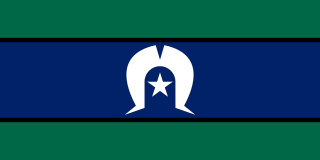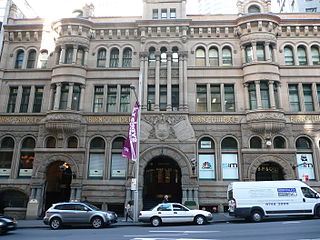Related Research Articles

The prehistory of Papua New Guinea can be traced to about 50,000–60,000 years ago, when people first migrated towards the Australian continent. The written history began when European navigators first sighted New Guinea in the early part of the 17th century.

Bougainville Island is the main island of the Autonomous Region of Bougainville, which is part of Papua New Guinea. Its land area is 9,300 km2 (3,600 sq mi). The highest point is Mount Balbi, on the main island, at 2,715 m (8,907 ft).

The Torres Strait, also known as Zenadh Kes, is a strait between Australia and the Melanesian island of New Guinea. It is 150 km (93 mi) wide at its narrowest extent. To the south is Cape York Peninsula, the northernmost extremity of the Australian mainland. To the north is the Western Province of Papua New Guinea. It is named after the Spanish navigator Luís Vaz de Torres, who sailed through the strait in 1606.

The Torres Strait Islands are an archipelago of at least 274 small islands in the Torres Strait, a waterway separating far northern continental Australia's Cape York Peninsula and the island of New Guinea. They span an area of 48,000 km2 (19,000 sq mi), but their total land area is 566 km2 (219 sq mi).

James Francis "Frank" Hurley was an Australian photographer and adventurer. He participated in a number of expeditions to Antarctica and served as an official photographer with Australian forces during both world wars. He was the official photographer for the Australasian Antarctic Expedition and the Imperial Trans-Antarctic Expedition of 1914–16.

Martin Elmer Johnson and Osa Helen Johnson were married American adventurers and documentary filmmakers. In the first half of the 20th century the couple captured the public's imagination through their films and books of adventure in exotic, faraway lands. Photographers, explorers, marketers, naturalists and authors, Martin and Osa studied the wildlife and peoples of East and Central Africa, the South Pacific Islands and British North Borneo. They explored then-unknown lands and brought back film footage and photographs, offering many Americans their first understanding of these distant lands.

Morobe Province is a province on the northern coast of Papua New Guinea. The provincial capital and largest city is Lae. The province covers 33,705 km2, with a population of 674,810, and since the division of Southern Highlands Province in May 2012 it is the most populous province. It includes the Huon Peninsula, the Markham River, and delta, and coastal territories along the Huon Gulf. The province has nine administrative districts. At least 101 languages are spoken, including Kâte and Yabem language. English and Tok Pisin are common languages in the urban areas, and in some areas pidgin forms of German are mixed with the native language.
Tourism in Papua New Guinea is a fledgling industry but there are attractions for the potential visitor which include culture, markets, festivals, diving, surfing, hiking, fishing and the unique flora and fauna. Papua New Guinea receives an increasing number of visitors each year, with approximately 184,000 international arrivals in 2015.

Burns Philp was a major Australian shipping line and merchant that operated in the South Pacific. When the well-populated islands around New Guinea were targeted for blackbirding in the 1880s, a new rush for labour from these islands began. James Burns and Robert Philp purchased several well-known blackbirding ships to quickly exploit the human resource in this region, and Burns Philp entered the slave trade. The company ended its involvement in blackbirding in 1886. In later years the company was a major player in the food manufacturing business. Since its delisting from the Australian Securities Exchange in December 2006 and the subsequent sale of its assets, the company has mainly become a cashed up shell company. It is wholly owned by Graeme Hart's Rank Group.
The following lists events that happened during 1885 in Australia.
Lucy Evelyn Cheesman was a British entomologist and traveller. Between 1924 and 1952, Cheesman went on 8 solo expeditions in the South Pacific, and collected over 70,000 specimens, which she accompanied with sketches and notes. These are now part of the collections of the Natural History Museum in London. Cheesman published extensively about her work and travels. In 1955, she was appointed an OBE for her services to science.

Jameson Thomas was an English film actor. He appeared in more than 80 films between 1923 and 1939.

Pocklington Reef is a coral reef and a mostly submerged atoll in the far southeast of Papua New Guinea.

Buin is a town on Bougainville Island, and the capital of the South Bougainville District, in the Autonomous Region of Bougainville, in eastern Papua New Guinea. The island is in the northern Solomon Islands Archipelago of the Melanesia region, in the South Pacific Ocean.

The Sepik is the longest river on the island of New Guinea, and the third largest in Oceania by discharge volume after the Fly and Mamberamo. The majority of the river flows through the Papua New Guinea (PNG) provinces of Sandaun and East Sepik, with a small section flowing through the Indonesian province of Papua.
The Hound of the Deep is a 1926 British–Australian silent drama film directed by Frank Hurley and starring Eric Bransby Williams, Lilian Douglas and Jameson Thomas. Unlike many Australian silent films, a copy of it survives today.
Pearl and Savages is a 1921 documentary by filmmaker Frank Hurley about the people of Papua New Guinea and Torres Strait.
Walter Sully (1895–1970) was an Australian cinematographer who worked for Cinesound Productions, Frank Hurley and Movietone. He was one of the leading newsreel cameramen of the 1930s.
The New Guinea Exploration Expedition of 1885 was a scientific, collecting and anthropological expedition sent by the Geographical Society of Australasia to the Fly River region of Papua New Guinea. The expedition lasted for six months from 10th June to 3rd December 1885, of which five months were spent in New Guinea. They named and explored the Strickland River, and made vast biological discoveries, including numerous species.
Frank Hurley: The Man who Made History is a 2004 documentary focusing on the work of photographer Frank Hurley. The documentary, written and directed by Simon Nasht, describes the highly controversial work of Frank Hurley after the discovery of his fabrication of many photos which were previously thought of as extremely significant.
References
- ↑ "AUSTRALIAN FILMS". The Register . Adelaide: National Library of Australia. 16 October 1926. p. 10. Retrieved 8 April 2012.
- ↑ ""THE JUNGLE WOMAN."". The Brisbane Courier . National Library of Australia. 22 June 1926. p. 10. Retrieved 8 April 2012.
- ↑ "AMUSEMENTS. STOLL-HURLEY FILM PRODUCTIONS". The Sydney Morning Herald . National Library of Australia. 8 September 1925. p. 5. Retrieved 8 April 2012.
- 1 2 Andrew Pike and Ross Cooper, Australian Film 1900–1977: A Guide to Feature Film Production, Melbourne: Oxford University Press, 1998, 132